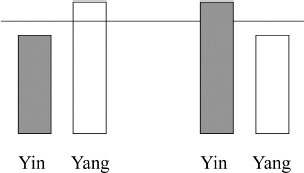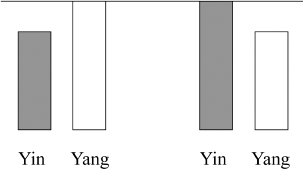The Yin–Yang relationship constitutes another essential part of Yin–Yang theory. There are four relationships between Yin and Yang
(1)Opposition: Yin and Yang are opposite stages of either a cycle or grouping, such as day vs. night, summer vs. winter, immaterial vs. material, moving vs. static, ascending vs. descending, upper vs. lower, left vs. right, heaven vs. earth, outside vs. inside, bright vs. shady, warm vs. cold, fire vs. water, immaterial vs. material, function vs. structure, rapid vs. slow, red tongue vs. pale tongue, artery vs. vein, and sympathetic nerves vs. parasympathetic nerves.
Yin–Yang opposition has the following features:
- Relativity: Nothing is totally Yin or totally Yang. Everything contains the seed of the opposite. Yin or Yang’s quality is relative. Vapor (energy) is Yang compared to water (matter) Yin. Vapor (matter) is Yin compared to heat (energy) Yang.
- Dynamic balance: Yin and Yang are not in a static 50–50 proportion but are in a dynamic and constantly changing balance. For example, the body’s temperature and hormone level stays in a nearly constant range (balance) but not static — such a dynamic balance is maintained by interaction between Yin and Yang.
- Constant interaction and “conflict”: Constant rebalancing promotes change and development of all things in nature.
- Infinity of division: Every object can be indefinitely divided from one into two, Yin and Yang.
- The Yin–Yang opposition leads to balance or harmony by nature, not just against each other.
- Between Yin and Yang, changes of Yang lead the changes of Yin, Yang leads the change.
(2)Interdependence: Yin cannot exist without Yang, and vice versa . Everything has mutually exclusive, yet interdependent, opposing forces.
(3)Mutual consumption: Dynamic balance of Yin and Yang is maintained by a continuous adjustment of the relative levels of Yin and Yang — a process of “quantitative” change between Yin and Yang. Yang’s increase may cause, or result from, Yin’s decrease, and vice versa. As stated in The Inner Canon of the Yellow Emperor, “Consumption of Yin leads to gaining of Yang” and “Consumption of Yang leads to gaining of Yin” . When Yin or Yang is out of balance, each affects the other by changing their proportions, then reaching a new balance.
Besides the normal state of Yin–Yang balance, there are four possible states of imbalance:
- Yin excess — a state of Full Cold. The level of Yin exceeds the normal, so Yin consumes Yang.
- Yang excess — a state of Full Heat. The level of Yang exceeds the normal, so Yang consumes Yin.
- Yin deficiency — a state of Empty Heat. The level of Yin is below the normal, which leads to relatively increased Yang.
- Yang deficiency — a state of Empty Cold. The level of Yang is below the normal, which leads to relatively increased Yin. This is most common for diseases in which there appear cold limbs, feeling cold, preference for hot drinks, lassitude, shortness of breath, low voice, a pale tongue with a white coating, and a deep or slow fine pulse.


Hence, Yang’s deficiency may cause, or result from Yin’s increase, and vice versa
- Yang predominates in the day, and thus the body’s physiological functions are predominately active. Yin predominates at night, and thus the body’s physiological functions are predominately depressed (at rest).
- “Heat results from a preponderance of Yang; cold results from a preponderance of Yin”
- Yang activities consume Yin nutrients, but Yin nutrient metabolism consumes a certain amount of Qi (Yang).
Matter being transformed into energy is preponderant during the day; energy being transformed into matter is preponderant at night. An increase in one is usually associated with a decrease in the other. It is important to note that matter accumulation (matter increasing with energy reducing) at night is for energy release during the day, and material reservation in winter is for active life (including new life) in spring. When this “waxing–waning of Yin and Yang” is beyond physiological limits, the Yin–Yang balance is impaired, and disease occurs.
In addition to the Yin–Yang mutual consumption, there are situations where both Yin and Yang will increase or decrease, one following the other, due to the Yin–Yang mutual-rooting relationship.9 Yang often dictates Yin in natural and social changes; so growth of Yang leads to growth of Yin, and decrease of Yang leads to decrease of Yin. Clinically, stronger Qi and function (Yang) often lead to better development (or recovery from damage) of organs and tissues (Yin); Qi (Yang) deficiency often leads to Blood (Yin) deficiency, and vice versa. A common treatment is to nourish Blood through tonification of Qi or to tonify Qi through nourishment of Blood.
(4)Inter-transformation: Yin and Yang are transformed into each other — a qualitative change. This often occurs at the “limit” or threshold of change or development.
- Day turns into night, summer turns into winter, life turns into death, and happiness turns into sorrow.
- “Yin starts at the summer solstice and Yang starts at the winter solstice”
- Yang syndrome may turn into Yin syndrome, e.g. continuous high fever consumes the body’s Yang and Qi energy, and may lead to the sudden cold limbs, pale face, and weak pulse of Yin.
- Excitement (Yang) may result from a little drinking, but over drinking may lead to depression (Yin).
Highlights of the Yin–Yang Relationship
- Yin–Yang opposition: Yin and Yang are opposite sides of an interdependent pair.
- Yin–Yang interdependence: Yin cannot exist without Yang, and vice versa.
- Yin–Yang mutual consumption: Yang’s increase may cause, or result from, Yin’s decrease, and vice versa.
- Yin–Yang inter-transformation: In extreme conditions, Yin turns into Yang and Yang turns into Yin.
- Dynamic balance is the core of the Yin–Yang theory.
- Yang commands and Yin follows in the Yin–Yang relationship. Increase/decrease of Yang leads to increase/decrease of Yin.

